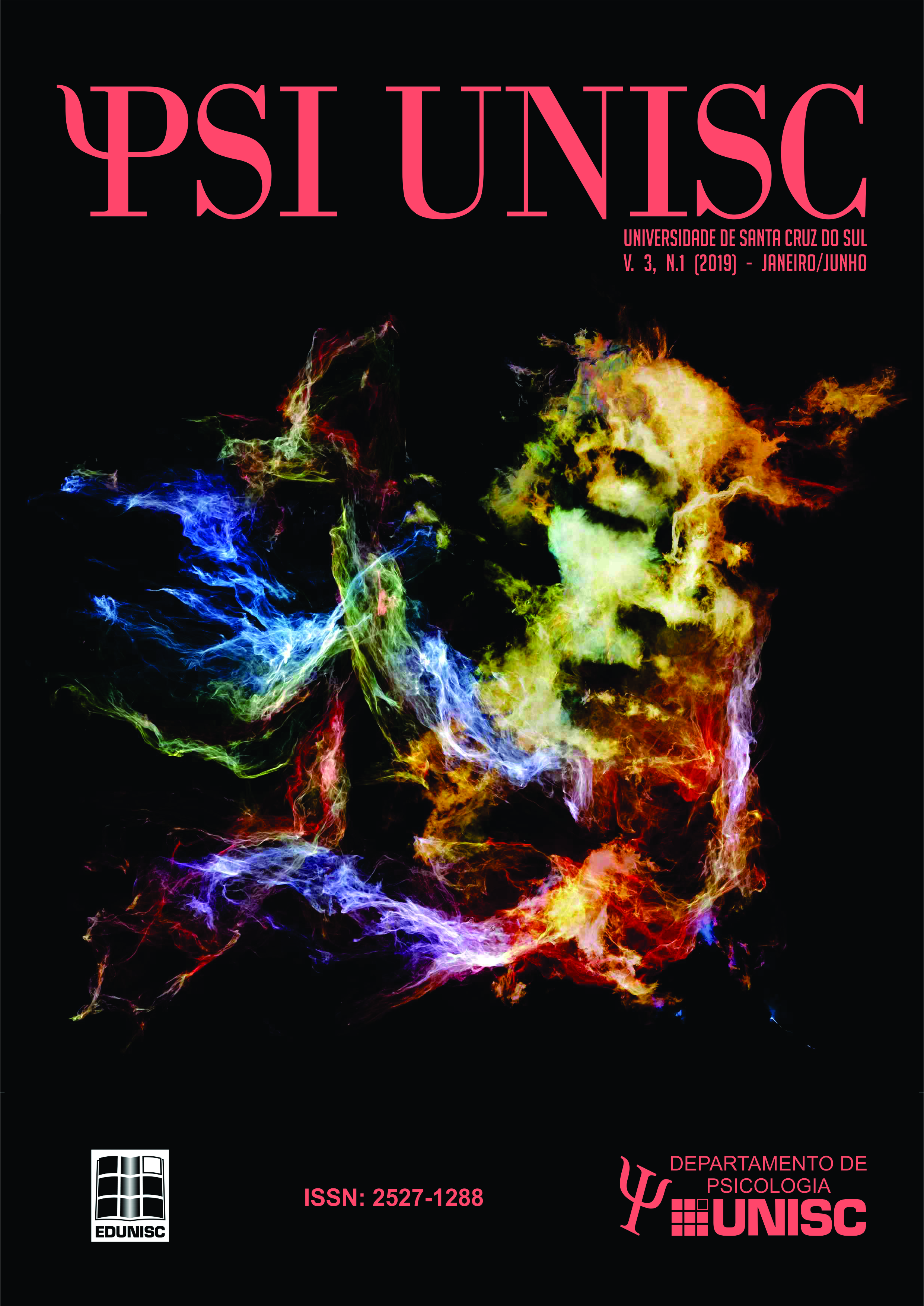Environmental psychology and health in the people-environmental relationship: a systematic review
DOI:
https://doi.org/10.17058/psiunisc.v3i1.12523Keywords:
Environmental psychology, Health, Restorative environment, Urban social identity, Environmental meaningAbstract
In desiring to understand the application of environmental psychology in the sphere of health proposes to contemplate the relationships that people establish with the places they inhabit. It is therefore objective to systematically revise literature in order to examine the concepts of restorative environment, environmental significance and urban social identity in relation to health Contexts. This triad contemplates the interaction of the subject with the spaces, emphasizing, above all, the search for Well-being. In order to do so, a systematic review of the literature was carried out in the BVS-PSI, Scielo, Lilacs, Pepsic data bases. In addition, the international databases that give access to the main journals of environmental psychology were contemplated: Science Direct and Sage journals. They resulted in twenty seven studies, analyzed and subdivided into three structured categories in order to contemplate the thematic, theoretical and methodological differences. Although they have distinct boundaries, the articles examined communicate with each other through the common perspective of investing in the search for health improvement strategies and health promotion considering the relationship with the Environment. In this way, scientific findings are expected to provide indicators and subsidies in the assessment and structuring of environmental actions and planning in the context of health care.Downloads
References
Abdulkarim, D., & Nasar, J. L. (2014). Are livable elements also restorative? Journal of Environmental Psychology, 38, 29–38. doi: 10.1016/j.jenvp.2013.12.003
Aragonés, J. I., & Amérigo, M. (1998). Psicología Ambiental. Madrid: Ediciones Pirámide.
Argiles, C. T. L., Kantorski, L. P., Willrich, J. Q., Antonacci, M. H., & Coimbra, V. C. C. (2013). Redes de sociabilidade: construções a partir do serviço residencial terapêutico. Ciência & Saúde Coletiva, 18(7), 2049–2058. doi: 10.1590/S1413-81232013000700020
Biedenweg, K., Scott, R. P., & Scott, T. A. (2017). How does engaging with nature relate to life satisfaction? Demonstrating the link between environment-specific social experiences and life satisfaction. Journal of Environmental Psychology, 50, 112–124. doi: 10.1016/j.jenvp.2017.02.002
Braveman, P., Egerter, S., & Williams, D. R. (2011). The social determinants of health: coming of age. Annual review of public health, 32, 381-398.
Cabassa, L. J., Parcesepe, A., Nicasio, A., Baxter, E., Tsemberis, S., & Lewis-Fernández, R. (2013). Health and wellness photovoice project: Engaging consumers with serious mental illness in health care interventions. Qualitative Health Research, 23(5), 618–630. doi: 10.1177/1049732312470872
Corraliza, J. A. (1998). Emoción y ambiente. In A. Y. & A. M. (Eds.), Psicologiía Ambiental (pp. 59–76). Madrid: Pirámide.
Felippe, M. L., Kuhnen, A., Silveira, B. B., & Lelli, G. (2017). What Is a Restorative Hospital Environment? Environmental Meaning, Affective Stress Restoration and Physical Attributes in Pediatric Inpatient Rooms. Children, Youth and Environments, 27(1), 17–46. doi: 10.7721/chilyoutenvi.27.1.0017
Felippe, M. L. (2015). Ambiente fisico e linguaggio ambientale nel processo di rigenerazione affettiva dallo stress in camere di degenza pediatrica (Tese de Doutorado). Departamento de Arquitetura e Urbanismo, Università degli Studi di Ferrara, Itália.
Fieldhouse, J. (2003). The impact of an allotment group on mental health clients’ health, wellbeing and social networking. British Journal of Occupational Therapy, 66(7), 286–296. doi: 10.1177/030802260306600702
Francis, J., Giles-Corti, B., Wood, L., & Knuiman, M. (2012). Creating sense of community: The role of public space. Journal of Environmental Psychology, 32(4), 401–409. doi: 10.1016/j.jenvp.2012.07.002
Francis, J., Wood, L. J., Knuiman, M., & Giles-Corti, B. (2012). Quality or quantity? Exploring the relationship between Public Open Space attributes and mental health in Perth, Western Australia. Social Science and Medicine, 74(10), 1570–1577. doi: 10.1016/j.socscimed.2012.01.032
Gidlow, C. J., Jones, M. V., Hurst, G., Masterson, D., Clark-Carter, D., Tarvainen, M. P., … Nieuwenhuijsen, M. (2016). Where to put your best foot forward: Psycho-physiological responses to walking in natural and urban environments. Journal of Environmental Psychology, 45, 22–29. doi: 10.1016/j.jenvp.2015.11.003
Gressler, S. C. (2014). O descanso e a teoria dos ambientes restauradores. Recuperado de http://repositorio.unb.br/handle/10482/15845
Hartig, T. (2011). Issues in restorative environment research: matters of measurement. In: B. Fernández-Ramírez, C. H., Villodres, C. M. S., Ferrer, M. J. M., Méndez (Orgs.), Psicología Ambiental 2011: entre los estudios urbanos y el análisis de la sostenibilidad (pp. 41-66). Universidad de Almería: Associación de Psicologia Ambiental (PSICAMB).
Hartig, T., & Staats, H. (2005). Linking preference for environments with their restorative quality. In From landscape research to landscape planning: Aspects of integration, education and application. (pp. 279–292).
Honold, J., Beyer, R., Lakes, T., & van der Meer, E. (2012). Multiple environmental burdens and neighborhood-related health of city residents. Journal of Environmental Psychology, 32(4), 305–317. doi: 10.1016/j.jenvp.2012.05.002
Kam, M. C. Y., & Siu, A. M. H. (2010). Evaluation of a horticultural activity programme for persons with psychiatric illness. Hong Kong Journal of Occupational Therapy, 20(2), 80–86. doi: 10.1016/S1569-1861(11)70007-9
Kaplan, R., & Kaplan, S. (1989). The experience of nature: A psychological perspective. (C. U. Press, Ed.).
Kjellgren, A., & Buhrkall, H. (2010). A comparison of the restorative effect of a natural environment with that of a simulated natural environment. Journal of Environmental Psychology2, 30, 464–472.
Kylén, M., Schmidt, S. M., Iwarsson, S., Haak, M., & Ekström, H. (2017). Perceived home is associated with psychological well-being in a cohort aged 67–70 years. Journal of Environmental Psychology, 51, 239–247. doi: 10.1016/j.jenvp.2017.04.006
Lefebvre, H. (2001). O direito à cidade (5a). São Paulo: Centauro.
Lima, E. M. F. A., & Yasui, S. (2014). Territórios e sentidos: espaço, cultura, subjetividade e cuidado na atenção psicossocial. Saúde Em Debate, 38(102), 593–606. doi: 10.5935/0103-1104.20140055
Lindal, P. J., & Hartig, T. (2013). Architectural variation, building height, and the restorative quality of urban residential streetscapes. Journal of Environmental Psychology, 33, 26–36. doi: 10.1016/j.jenvp.2012.09.003
Manzo, L. (2003). Beyond house and haven: toward a revisioning of emotional relationship with places. Journal of Environmental Psychology, 23, 47–61.
Matos, B. G. de, & Moreira, L. H. de O. (2013). Serviço residencial terapêutico: o olhar do usuário. Escola Anna Nery - Revista de Enfermagem, 17(4), 668–676. doi: 10.5935/1414-8145.20130010
Ministério da Saúde. Secretaria de Atenção à Saúde. Departamento de Ações Programáticas e Estratégicas. (2004). Residências terapêuticas: o que são, para que servem? Brasília, DF.
Ministério da Saúde. SAS/DAPES. Coordenação Geral de Saúde Mental, Álcool e Outras Drogas. Saúde Mental em Dados – 12, Ano 10, nº 12, outubro de 2015. Brasília, DF.
Mourão, A. R. T., & Cavalcante, S. (2006). O processo de construção do lugar e da identidade dos moradores de uma cidade reinventada. Estudos de Psicologia, 11(2), 143-151.
Mourshed, M., & Zhao, Y. (2012). Healthcare providers' perception of design factors related to physical environments in hospitals. Journal of Environmental Psychology, 32(4), 362-370.
Muenchberger, H., Ehrlich, C., Kendall, E., & Vit, M. (2012). Experience of place for young adults under 65 years with complex disabilities moving into purpose-built residential care. Social Science and Medicine, 75(12), 2151–2159. doi: 10.1016/j.socscimed.2012.08.002
Oliveira, R. W. (2013). The psychiatric reform ways: Therapeutic assistance and propagation in metropolis . Psicologia e Sociedade, 25(SPECIALISSUE 2), 90–94. Retrieved from http://www.openpsychodynamic.com/?page_id=32
Pol, E. (1996). La apropiación del espacio. Cognición, representación y apropiación del espacio, 45-62.
Ponte, A. Q., Bomfim, Z. Á. C., & Pascual, J. G. (2009). Considerações Teóricas Sobre Identidade De. Psicologia Argumento, 27(59), 345–354.
Rapoport, A. (1990). Levels of meaning and types of environments. In Y. Yoshitake et al,. (Eds.), Current Issues in Environmental-Behavior Research, Proceedings of the Third Japan-US Seminar, University of Tokyo, Kyoto, Tokyo (pp. 135-147).
Ratcliffe, E., Gatersleben, B., & Sowden, P. T. (2013). Bird sounds and their contributions to perceived attention restoration and stress recovery. Journal of Environmental Psychology, 36, 221–228. doi: 10.1016/j.jenvp.2013.08.004
Rollins, J. A. (2004). Evidence-based hospital design improves health care outcomes for patients, families, and staff. Pediatric Nursing, 30, 338-339.
Roster, C. A., Ferrari, J. R., & Jurkat, M. (2016). The dark side of home: Assessing possession “clutter” on subjective well-being. Journal of Environmental Psychology, 46, 32–41. doi: 10.1016/j.jenvp.2016.03.003
Santos Junior, H. P. de O. S., & Silveira, M. de F. de A. (2009). Práticas de cuidados produzidas no serviço de residências terapêuticas : percorrendo os trilhos de retorno à sociedade. Revista Escola de Enfermagem USP, 43(4), 788–795.
Shepley, M. M. C., Watson, A., Pitts, F., Garrity, A., Spelman, E., Fronsman, A., & Kelkar, J. (2017). Mental and behavioral health settings: Importance & effectiveness of environmental qualities & features as perceived by staff. Journal of Environmental Psychology, 50, 37–50. doi: 10.1016/j.jenvp.2017.01.005
Silva, D. S., & Azevedo, D. M. (2011). As novas práticas em saúde mental e o trabalho no serviço residencial terapêutico. Escola Anna Nery, 15(3), 603–609. doi: 10.1590/S1414-81452011000300023
Silveira, M. de F. de A., & Santos Junior, H. P. de O. (2011). Que eles falem por si: relatos dos profissionais sobre a experiência nas residências terapêuticas. Ciência & Saúde Coletiva, 16(4), 2089–2098. doi: 10.1590/S1413-81232011000400008
Soilemezi, D., Drahota, A., Crossland, J., Stores, R., & Costall, A. (2017). Exploring the meaning of home for family caregivers of people with dementia. Journal of Environmental Psychology, 51, 70–81. doi: 10.1016/j.jenvp.2017.03.007
Tabrizian, P., Baran, P. K., Smith, W. R., & Meentemeyer, R. K. (2018). Exploring perceived restoration potential of urban green enclosure through immersive virtual environments. Journal of Environmental Psychology, 55, 99–109. doi: 10.1016/j.jenvp.2018.01.001
Ulrich, R. S. (1984). View through a window may influence recovery from surgery. Science, 224(4647), 420–421. doi: 10.1126/science.6143402
Ulrich, R. S., Zimring, C., Zhu, X., DuBose, J., Seo, H., Choi, Y., et al. (2008). A review of the research literature on evidence-based healthcare design (part I). Health Environments Research and Design, 1, 61-125.
Ulrich, R. S., Simons, R. F., Losito, B. D., Fioritom, E., Miles, M. A., & Zelson, M. (1991). Stress recovery during exposure to natural and urban environments. Journal of Environmental Psychology, 11(3), 201–230. doi: 10.1016/S0272-4944(05)80184-7
Valera, S., & Pol, E. (1994). El concepto de identidad social urbana: una aproximación entre la psicología social y la psicología ambiental. Anuario de psicología/The UB Journal of psychology, (62), 5-24.
Wright, P. A., & Kloos, B. (2007). Housing environment and mental health outcomes: A levels of analysis perspective. Journal of Environmental Psychology, 27(1), 79–89. doi: 10.1016/j.jenvp.2006.12.001
Yasui, S. (2010). Rupturas e encontros: desafios da reforma psiquiátrica brasileira. SciELO-Editora FIOCRUZ
Downloads
Published
How to Cite
Issue
Section
License
The submission of originals to this journal implies the transfer, by the authors, of the printed and digital publication rights. The copyrights for the published articles are those of the author, with periodical rights on the first publication. Authors may only use the same results in other publications clearly indicating this journal as the medium of the original publication. Because we are an open access journal, we allow free use of articles in educational and scientific applications provided the source is cited under the Creative Commons CC-BY license.




